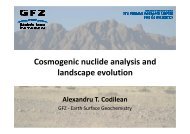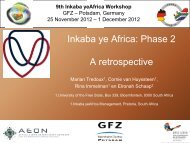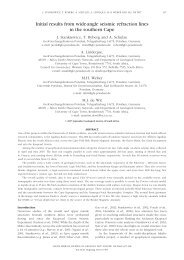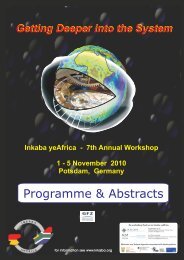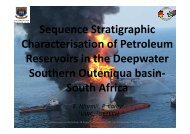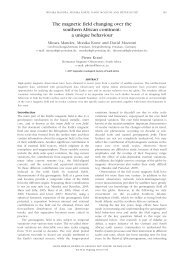South Africa - Inkaba.org
South Africa - Inkaba.org
South Africa - Inkaba.org
Create successful ePaper yourself
Turn your PDF publications into a flip-book with our unique Google optimized e-Paper software.
High-precision steering and pointing control of a satellite/lunar<br />
laser ranging telescope<br />
G.L. Nickola 1 and W.L. Combrinck 2<br />
1. University of <strong>South</strong> <strong>Africa</strong> (UNISA) and Tshwane University of Technology, <strong>South</strong> <strong>Africa</strong>,<br />
lnickola@unisa.ac.za<br />
2. Hartebeesthoek Radio Astronomy Observatory (HartRAO) Space Geodesy programme, <strong>South</strong> <strong>Africa</strong>,<br />
ludwig@hartrao.ac.za<br />
ABSTRACT<br />
A Satellite Laser Ranging System (SLRS) enhanced for Lunar Laser Ranging (LLR) is being developed as part of<br />
geodetic instrumentation to be located at a new fundamental space geodetic station for <strong>South</strong> <strong>Africa</strong>.<br />
The project under discussion here, will involve the development of high-precision steering and pointing control for<br />
the LLR telescope. The role of the pointing system is to safely point the telescope towards the desired target and to<br />
track the target in spite of internal and external disturbances. With the need for high-precision accuracy and<br />
regulation, feedback control is required. The basis of a telescope’s closed-loop system consists of continuously<br />
comparing the actual pointing direction to the desired pointing direction and feeding back any difference to the<br />
drive system for correction.<br />
An emphasis on safety aspects will be the most important design consideration of all. This will include hard-wired<br />
safety interlocks as well as software protection for humans as well as the equipment. The mechanical design of the<br />
telescope will determine some of the control design criteria. Compensation for mechanical behaviour will be<br />
required in the control software.<br />
National Instruments (NI) LabVIEW is a graphical programming language that is ideal for use in developing<br />
engineering applications. LabVIEW programs use virtual instruments which have the look and feel of physical<br />
systems or instruments. A working model using LabVIEW and an NI CompactRIO interface will be developed. NI<br />
9514 motion control modules with encoder feedback will be used for control of the telescope’s two axes (azimuth<br />
and elevation). An NI 9401 8-channel input/output module will be used for other circuitry. Vagon AC-drive units<br />
with 3-phase asynchronous motors will be used to drive the model.<br />
KEYWORDS: lunar laser ranging, telescope control.<br />
62



